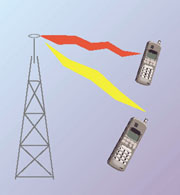|
.gif)
 |
| Smart antennas allow narrow beams
to be directed to a subscriber while supressing interference |
As mobile phone technology moves
towards 3G (Third Generation) with data flow speeds about 200 times faster
than 2G, a research project at HKUST has formulated an algorithm that
helps in the optimisation of signal performance.
 3G employs
CDMA (Code Division Multi Access) technology which allows many users to
share the same bandwidth simultaneously. Users are each allocated a unique
code which enables them to extract their own signal. Theoretically there
should be no signal interference. In reality with thousands of users,
says Principal Investigator Prof Khaled Ben Letaief, interference can
be a serious problem. As a solution, the researchers considered the use
of MIMO technology where smart antennas are combined with advanced temporal
processing. 3G employs
CDMA (Code Division Multi Access) technology which allows many users to
share the same bandwidth simultaneously. Users are each allocated a unique
code which enables them to extract their own signal. Theoretically there
should be no signal interference. In reality with thousands of users,
says Principal Investigator Prof Khaled Ben Letaief, interference can
be a serious problem. As a solution, the researchers considered the use
of MIMO technology where smart antennas are combined with advanced temporal
processing.
 Different
configurations of multiple antennas were considered. Because of cost,
especially attractive was the use of multiple antennas at the base station
and the simplest possible mobile receivers. Different
configurations of multiple antennas were considered. Because of cost,
especially attractive was the use of multiple antennas at the base station
and the simplest possible mobile receivers.
 Applying new
techniques, the researchers devised advanced architectures with the corresponding
signal processing algorithm. “Results show a huge increase in system
performance,” said Prof Letaief. Applying new
techniques, the researchers devised advanced architectures with the corresponding
signal processing algorithm. “Results show a huge increase in system
performance,” said Prof Letaief.
Principal
Investigator
Prof Khaled Ben Letaief : eekhaled@ee.ust.hk

|


